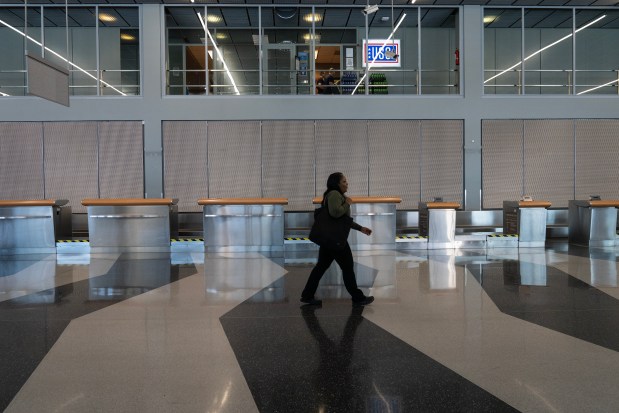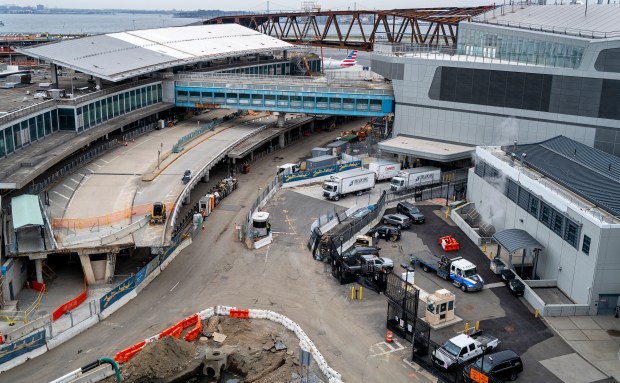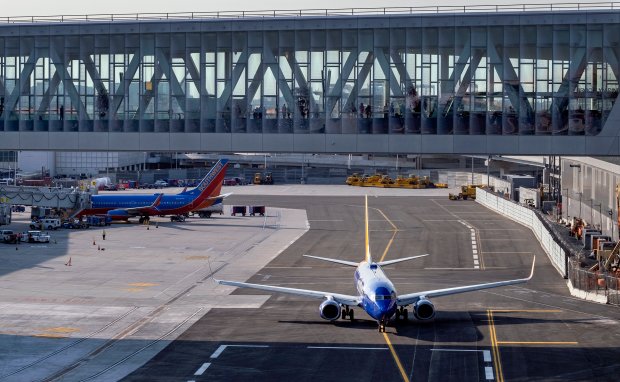A few years before Chicago reached an agreement with the city’s airlines to overhaul O’Hare International Airport, New York officials jump-started a rebuild of LaGuardia Airport.
After years of discussion, planning and a design competition for the New York airport, in 2015 a development team got the go-ahead to begin the first piece of what would come to be an $8 billion rebuild of most of LaGuardia.
Nine years later, two new lauded terminals at the airport are open, and the last of the terminal work is set to be finished this year.
In Chicago, the centerpiece of the O’Hare construction has stalled, mired in debate about cost overruns and how to move forward.
The O’Hare overhaul, negotiated by then-Mayor Rahm Emanuel in 2018, included a broad rebuilding and expansion of the airport. The heart of the project was replacing aging Terminal 2 with a gleaming new Global Terminal, and adding two satellite concourses.
Parts of the overhaul have been completed, but the key terminal rebuild has yet to get off the ground. O’Hare’s two main air carriers — United and American, who are on the hook for much of the original $6.1 billion price tag associated with terminal work — pushed back against higher costs. Negotiations between the city and the airlines turned contentious and spilled into public view, and earlier this month, the city proposed a path forward that involved reshuffling the order of construction and prioritizing work on the Global Terminal, something the airlines had pushed for and that had been blasted by U.S. Sen. Dick Durbin.
Delays and cost overruns in major construction projects are not unusual, but other airports that serve as major Midwest hubs have moved forward with plans, such as American Airlines’ hub at Dallas Fort Worth. As the O’Hare terminal project struggles, the key role the airport plays in both the nation’s air system and the city’s economy hangs in the balance.
In New York, the LaGuardia rebuild was pushed forward by powerful politicians committed to the project, and the work was managed through a partnership with private sector companies. The New York airport is also a different type of market for the airlines, making them more willing to absorb higher costs, for example. But the LaGuardia project offers one example of how a complex, multibillion-dollar terminal rebuild at a crowded airport moved forward.
‘A strong arm and a powerful presence’
The rebuild of LaGuardia — an airport that is smaller than O’Hare, and crammed into a plot of land along the water — did not unfold flawlessly. But by 2015 the agency that oversees the airport, the Port Authority of New York and New Jersey, had selected a private development team to demolish and rebuild one of the airport’s terminals for $3.6 billion. The team would design, build, operate and maintain the new terminal.
The following year the Port Authority approved an agreement with Delta Air Lines to rebuild, and largely pay for, another terminal, with work expected to be finished in 2024. By then, the total cost for the airport work was $8 billion.
Even after it began, the project had challenges that came with their own costs. News outlets reported traffic snarls so severe at times during construction that taxis and buses couldn’t get close enough to pick up or drop off passengers, some of whom resorted to lugging suitcases down the main highway near the airport to get to the terminals. And plans to build a train link to the airport were reportedly abandoned as costs grew and Gov. Andrew Cuomo, who championed the project, left office in disgrace.
Still, by 2022, after the challenges of the pandemic and the opportunities presented by a sharp drop in airport use, the first of the terminals was finished, with two satellite concourses and pedestrian skybridges. The arrivals and departures hall of the second terminal, under Delta’s purview, opened months later, and work is expected to be finished this year.
New York officials have said the rebuild cost $8 billion, in line with 2016 estimates. It was funded mostly by private financing, with the Port Authority chipping in.
Mitchell Moss, former director of the Rudin Center for Transportation at New York University, said the project’s culmination came down to political will. When then-Vice President Joe Biden compared the airport to something that could be found in “a third-world country,” Cuomo was spurred to act.
“Gov. Cuomo ruled with a strong arm and a powerful presence,” Moss said. “And that is what made the Port Authority get the airport done in a timely way.”
Also playing a key role is the public-private partnership developing and operating one of the terminals at the New York airport, said Justin Marlowe, director of the Center for Municipal Finance at the University of Chicago. Though government agencies set standards for the airport, the partnership is responsible for running it, meaning the partnership likely was driven to help design and build the new terminal efficiently, he said. And because they are also operating the terminal, the companies involved stand to make money once the airport is up and running and meeting standards, so they have a strong incentive to get the project finished.
The partnerships can be controversial, though. In Denver, a public-private partnership tasked with completing a planned $650 million terminal renovation reportedly fell apart in 2019.
And the partnerships have long been met with skepticism in Illinois, Marlowe said. Plus, Chicago’s record of bringing the private sector into public infrastructure is questionable, he said. In an infamous 2008 deal, the city leased its parking meters to a private investment firm for an infusion of cash, and the firm recouped the cost and began profiting off the meters with decades left on the lease.
Still, Marlowe said, those efforts reflected political will. And regardless of how it got done, the completion of LaGuardia can be a comparison for business leaders who want to see if it’s possible for Chicago to complete a major infrastructure project, he said.
“When the political will is there, these things happen, one way or another,” he said.
The Chicago Department of Aviation and Mayor Brandon Johnson’s office did not answer specific questions about the O’Hare construction project or its latest budget estimates. In a statement, the aviation department said the city was continuing to work with airlines on the project, “including program budget and impacts on operations.”
The aviation department later issued another, lengthy statement, saying it was in a “formal review” process with the airlines about the order of construction, and would provide more detailed updates about the next steps when the process was finished. The mayor and city are committed to “responsibly” developing O’Hare, according to the statement.
A public-private partnership, like that at LaGuardia, provides private entities with airport revenue after the project is finished, in exchange for financing and assuming risks, the aviation department said. The model in use at O’Hare helps provide coordination during design of the project, and allows the city to keep control of airport revenue and operation after the project is finished.
“We are not trying to overbuild at O’Hare, but we cannot under build, either,” the agency said in a statement. “A significant portion of the planned investment will replace aging and functionally obsolete terminal facilities, and Chicago must have airport infrastructure that allows us to remain a competitive economic center on the global stage both today and tomorrow.”
The O’Hare project
In Chicago, early plans for the Global Terminal, intended to allow travelers to move more easily between domestic and international flights, progressed with much fanfare. They were part of what was billed as the largest and most expensive terminal revamp in O’Hare’s history, a piece of a broader overhaul initially pegged at $8.5 billion. The price tag later rose to $12.1 billion.

The city launched an opaque selection process to pick design teams for the new terminal and satellites, with Emanuel saying at the time picking an architect was a priority before he left office in 2019. That year, the city selected a team led by hometown star Jeanne Gang to design the Global Terminal. Architecture firm Skidmore, Owings & Merrill, known for designing the Willis Tower and the former John Hancock Center, would design the two satellite concourses.
At the time, the city said ground could be broken for the satellite concourses in 2022, and the global terminal in 2023.
But costs grew and delays mounted as the project endured through three mayors, two aviation department chiefs, the COVID-19 pandemic, and inflation.

Some progress has been made. In 2022 the redevelopment plans got federal environmental approval to move forward. A renovation and expansion of Terminal 5, included in the original airport overhaul plans, made room for Delta to move in, vacating its space in Terminal 2 before construction began.
But the major work to rebuild Terminal 2 as the Global Terminal and add the satellite concourses has yet to take off.
Earlier this month, the city proposed changing the sequencing of construction, opting to “accelerate the completion of the Global Terminal,” Chief Operating Officer John Roberson said. Initially, the two satellite concourses were to be built first, which would have added gate space for airlines to use while Terminal 2 was rebuilt. Now, if the budget is maxed out building the first concourse and the Global Terminal, some warn the second satellite could be in danger.
A change in the order of construction had been sought by airlines, who wanted to ensure the new terminal wasn’t threatened by future budget issues after the two satellites were built.
U.S. Sen. Dick Durbin has pushed for the project to proceed as originally planned, worrying that changing the order would mean the second satellite concourse could be indefinitely delayed or cut. In a letter earlier this month to U.S. Secretary of Transportation Pete Buttigieg, Durbin wrote that the bulk of new gate capacity at the airport was to come from the second satellite.
“It cannot be overstated that both Chicago and the Midwest’s economic success and connectivity are at stake in this decision — a decision in which USDOT and the FAA have a vested interest, considering O’Hare’s present success as a top asset within the national aviation system,” he wrote, urging Buttigieg to convene a meeting with the city, airlines and state congressional delegation on the project.
The city’s aviation department, in its statement, said moving the Global Terminal up in the construction order “prioritizes the ability for O’Hare’s hub airlines to co-locate with their airline alliance partners, allowing for shorter international connections, improved operations and a smoother passenger experience.”
The aviation department later said the plan put forward to airlines earlier this month focused on “near-term flexibility while preserving long-term growth.”
Airport costs
O’Hare is not the first airport to encounter budget overruns. For example, the same port authority that manages LaGuardia last year increased its funding authorization for work at John F. Kennedy International Airport by $1 billion, Bloomberg has reported.
But at O’Hare, United and American airlines, footing a large part of the construction bill, have pushed back against rising costs. An estimate they received last June put the project $1.5 billion over budget in 2018 dollars, they said.
They worry the overruns and delays will raise the cost of flying passengers through O’Hare enough that they will no longer want to use the airport as a hub.
Already, air traffic at O’Hare has changed. The Tribune reported last year that O’Hare’s recovery from the pandemic lagged the recovery nationwide.
And in a preliminary ranking issued this month of the busiest airports in the world, O’Hare ranked ninth for number of passengers in 2023, down from fourth in 2022 and sixth in 2019. Midwest airports in Denver and Dallas have leapfrogged over O’Hare since the onset of the pandemic in the ranking from Airports Council International.

The LaGuardia project significantly increased American Airlines’ costs at the airport, the carrier said, but the New York market is different than Chicago. LaGuardia serves mostly local passengers leaving from or arriving to New York, and the airport doesn’t compete with other connecting hubs like O’Hare does. The airlines feel they can absorb higher costs in New York, and there are few lower-cost airports nearby.
But O’Hare serves as a major hub for connecting passengers, and the airlines are more sensitive to the cost of flying customers through the airport – especially if a competitor can move passengers through a different Midwest hub for cheaper.

In 2022, the average cost to an airline per passenger at O’Hare was $25.98, largely on par with costs at LaGuardia and Los Angeles International Airport, according to information provided by the airlines. Other Midwest airports in Detroit and Minneapolis, which serve as hubs for rival Delta Air Lines, cost less than $10 per passenger.
Dallas Forth Worth International Airport, American Airlines’ major hub, cost just over $12 per passenger. Denver, a fast-growing hub for United, cost a little over $10 per passenger at that time.
Midway, Chicago’s smaller airport and a key hub for Southwest, cost almost $14 per passenger in 2022, according to the data.
The O’Hare construction project is, admittedly, complex, said Hani Mahmassani, director of the Northwestern University Transportation Center. Maintaining the flow of passengers in a congested airport during construction will always involve some pain, and setbacks are not unusual. Underestimating initial costs is also common to get approval, he said.
But an independent agency might be better equipped to handle a large-scale project than a city department, he said.
“I just don’t know how committed the (airlines are) going to be to seeing this one airport rise to the occasion,” he said, “Unless there is a local, strong commitment to see that happen.”
Chicago Tribune’s Jake Sheridan contributed



